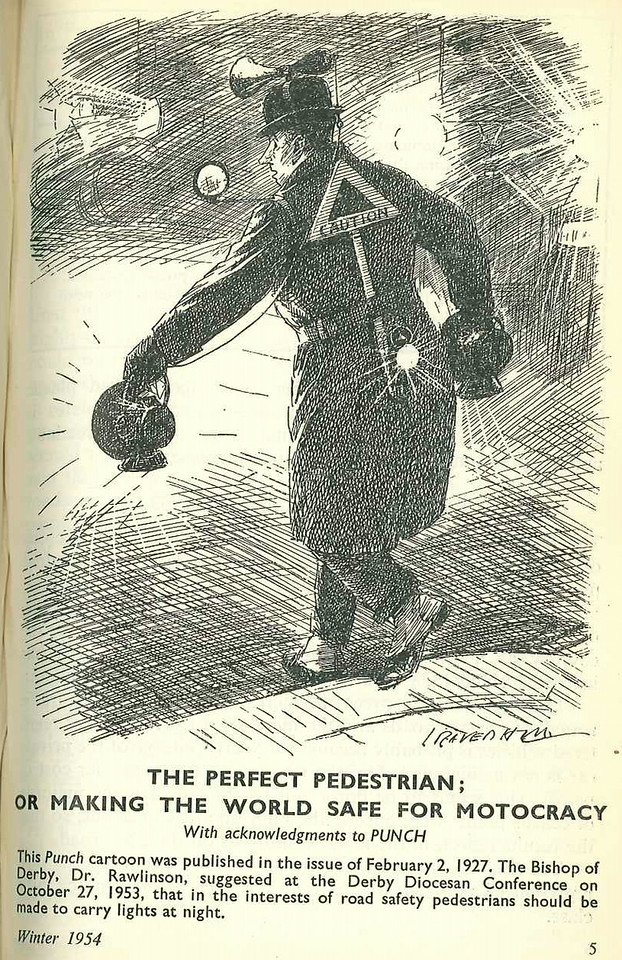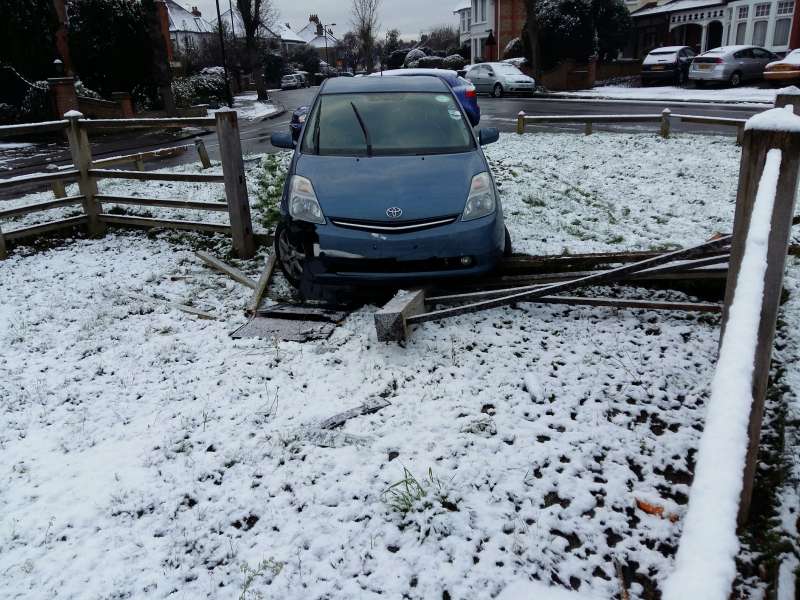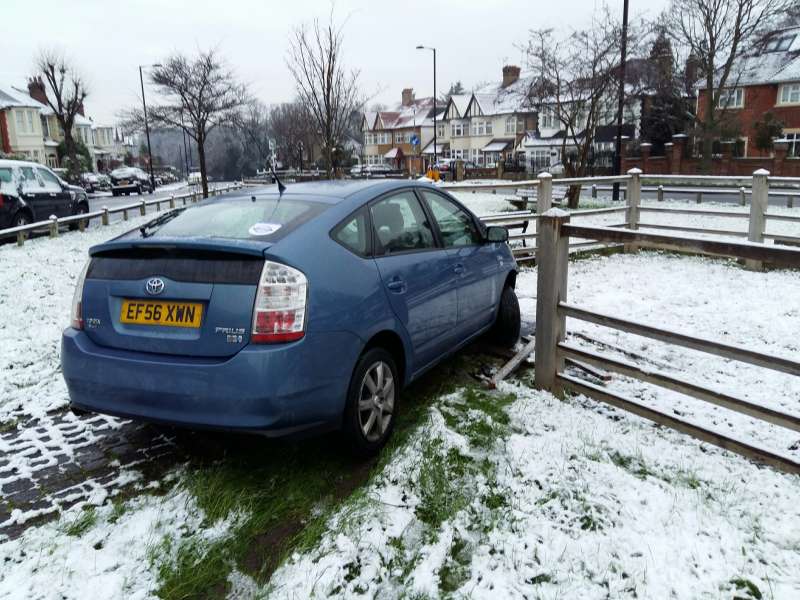Forum topic: Cycling in Enfield - the view from the saddle - Episode 1
Cycling in Enfield - the view from the saddle continued
David Hughes
24 Nov 2015 23:28 #1801
- David Hughes
-
 Topic starter
Topic starter
Share
![]()
![]() Share by email
Share by email
"But then the carriageway situation cleared, the car behind me accelerated fast, cut in front of me to avoid a central island, braked hard, then signaled and went left. There was no real danger to me (a touch on a brake probably, but I don't recall), but what was the point? What were the dangers?
Time saving for the driver, probably a few seconds. Consequence for pedestrians? Probably the sound of a disturbing growl of acceleration, which is the sort of thing which makes parents worry about letting their kids bike. For me? A brief primordial flash of fear before thinking kicked in. For pedestrians and me a very unhealthy burst of exhaust."
The thing is that incidents of a similar ilk are not uncommon, and the settings are city streets not rural roads designed primarily for traffic. Palmers Green is a place to live for heaven's sake.
And there are other behaviours, ordinary everyday behaviours, which defy logic. My favourites are charging red lights, acceleration pedal down until the last moment before braking hard, or a similar silliness, racing toward evident congestion (Happens on Green Lanes these days at the road works adjacent to the North Circular Road). These behaviours may sometimes be dangerous as well as consuming fuel, emitting pollutants and adding to climate change unnecessarily, but they also risk discouraging walking and cycling, and are always an antisocial and discourteous behaviour.
A particular frightener for bikers - not uncommon at Fox Lane's side street entrances and undermining the Highway Code stipulation that pedestrians have right of way at the mouth of a side street - is swinging out to the right to enter a side street at speed. Note that houses or garden foliage can block the view of both the driver, who can't see round the corner, and the biker turning right who should be moving to the centre of the road and is therefore in a very perilous position.
These examples, particularly the second, are in sense simply examples of thoughtless/selfish individual behaviour, but I think that it is the licence that cars have been allowed, allocated even, which have created a sense of driver entitlement:. The effects are considerable: kids deprived of independence and exercise, the collapse of cycling until government at all levels - in Enfield at any rate - woke up, and, even worse, the near death of a walking culture.
Now here's my list of the catastrophic decisions which have created the sort of nonsense I've described:
1. The increase in the default urban speed limit from 20mph to 30mph back in the last century.
2. Not - as some counties have done and in a sense some councils have now done by installing tables at the mouths of side streets - extending pavements across the entry to side streets.
3. Installing pedestrian crossing rather than lower the speed limit to a calmed 20mph (pedestrian crossings encourage speed between crossing by implying the carriageway between them is driver territory).
4. Installing pavement railings to curtail parking near shops which, although it wasn't intended, created the impression of pedestrians were being corralled like cattle to avoid bothering drivers. (Fortunately, hopefully, this practice seems to be on the wane, with some railings being removed.)
5. Implied 'blaming the victim' by suggesting/insisting that kids in particular should wear high viz clothing on the way to school. (Some might say - I certainly would - that no driver on a street leading to school should ever be above 30kph, but on my street some parents, probably either late or lusting after a parking place, and with kids in the car, are doing every bit 60kph or even more.).
Enough for this spell, I'm tiring, so I'll add more when I have a moment. Meanwhile, if you think I am, where am I getting this wrong?
Please Log in or Create an account to join the conversation.
Cycling in Enfield - the view from the saddle continued
David Hughes
26 Nov 2015 23:26 #1805
- David Hughes
-
 Topic starter
Topic starter
Share
![]()
![]() Share by email
Share by email
On the other hand I think he was demonstrating an unconscious sense of entitlement; for him being in a car assures priority.
We see the phenomenon all the time e.g. impatience behind three cyclist abreast and gossiping, yet inside the car a driver and two passengers may well be gossiping, driving fast along the access to a school where kids are walking, passing me on my bike with only a centimetre to spare because otherwise s/he would have to slow down, driving fast through residential streets, rat-running; I could go on.
The question is: "What caused this sense of entitlement?" First candidate must be that the inherent weight and speed of cars confers a sense of power. Which could have been mitigated from the beginning but unfortunately in the 1930s 30mph was chosen as the default speed limit in any area with street lights; therefore in urban areas. Much too fast as it has turned out, but understandable when there were very few cars on the road and pedestrians had plenty of opportunities to cross the carriageway safely between them.
Fast forward to when I took my driving test in 1958 at the age of 21. The number of cars was growing, and so was the carnage. But nothing much was done, and looking back it was about this time when the rot set in; pedestrians became subservient.
How?
Firstly by widening streets - sometimes sacrificing graceful buildings as in my home town - to improve traffic flow, which also lengthened sightlines. Then by installing more pedestrian crossings, and creating so-called zebra crossings. What a cocktail of calamity, though at the time people thought longer sightlines would make it safer for pedestrians rather than what actually enabled: higher traffic speed.
Improving traffic flow is one thing, but an unintended consequence is more cars to add to the higher speed. Long sight lines are another, but they also encourage speed. More pedestrian crossings make it safer for pedestrians, but they also encourage speed between crossings whilst pushing pedestrians out of their preferred/best route. The beginning of pedestrians as second class citizens had begun.
And, it seems to me, this is the beginning of the national mindset, the sense of entitlement, which causes drivers to resent anything - in the current situation a proposed growth in cycling - which bars or might bar them from dominating the road and choosing their most convenient route rather than routes which are in the interest of the community at large. Furthermore rat-running was becoming a possibility though I think it was the late 1970s before I heard the phrase.
How to cope with mindset and a sense of entitlement, to overcome them when necessary, is the need, especially in the case of the people with power who can encourage or enforce change. It's a problem because they are internalized and felt as just or right. Personally I don't have the answer but you'd hope that logic and explanation tied in with courage and tenacity would help.
Raising awareness of the phenomenon must be vital, and minds open enough to acknowledge it equally so.
Please Log in or Create an account to join the conversation.
"Motocracy"
Basil Clarke
27 Nov 2015 23:15 #1811
- Basil Clarke
-

Share
![]()
![]() Share by email
Share by email
I think he was demonstrating an unconscious sense of entitlement; for him being in a car assures priority.
Here's evidence that what David's describing goes back at least to the 1920s and that there's even a word for it - "Motocracy":
And here's one from 1910!
And it even pre-dates the motor car era!
The caption more or less equates to "Jean, do tell me that the horses aren't injured!"
(Cartoons discovered on Twitter )
Please Log in or Create an account to join the conversation.
The view from the saddle
David Hughes
01 Dec 2015 18:36 #1825
- David Hughes
-
 Topic starter
Topic starter
Share
![]()
![]() Share by email
Share by email
The scene was this: I was travelling along High Street between Southgate Green and Southgate proper. It's not a wide carriageway and there were cars parked on either side at the point where the incident occurred.
As is commonly the case I was both watching the road in front - cars coming and parallel with me - and listening for noise behind me; I could tell there was at least one vehicle behind, but the revs were low so I wasn't concerned. Suddenly there was a noise as steel clashed with steel and I felt a tug at my right elbow; the car's engine revs dropped even further but it drifted past.
The driver didn't stop. I wasn't shaken and barely felt the blow.
But what should we make of the incident?
Clearly space was tight for two parallel moving cars and a bike; the driver probably shouldn't have tried to pass. On the other hand, and as I've said, the revs were low on the approach, remained low as the car went past and it's pace was slow until it went out of sight. I'd take a bet the driver was puzzled by the sound of a clash.
Questions: why did the driver try to pass in such a narrow space especially as cyclists do wobble, and was there a as a sense of entitlement?
Answering the second question first I think this was a courteous driver who didn't in this context have a sense of entitlement, but it's possible his/her personality would be very conscious of pressure behind from other drivers. We'll never know, but either way no one should pass that close to a cyclist who might wobble just from striking a small stone or hitting a pothole.
Please Log in or Create an account to join the conversation.
The view from the saddle
David Hughes
18 Dec 2015 17:26 #1909
- David Hughes
-
 Topic starter
Topic starter
Share
![]()
![]() Share by email
Share by email
No, not you! But that driver who caught me biking past a row of parked cars, and despite the narrow gap between me and on-coming traffic, sailed past leaving me a few centimetres to spare. The slightest wobble and..........curtains.
This happens all the time. In my prejudiced(?) mind by drivers impatient and feeling entitled to the carriageway. And no wonder. Time, and well-meaning administrations keen not to interrupt traffic flow, have consistently made it more difficult for pedestrians and cyclists to find safe pathways for their chosen routes, and done next to nothing to curb the impatience of people who sit behind a steering wheel. Preference breeds entitlement on the roads as in social status.
So here is my plea; I am not a lesser person with fewer rights to complete my journey safely when I leave the car at home and choose to ride my bike. Wait until it's safe to pass because, competent cyclist that I am, I can still wobble if the road surface is poor, if I loose concentration, and, God forbid, a driver in a parked car opens her/his door as I arrive.
Cyclist can wobble at any time.
The other day a rare thing happened: I gave my wife a lift in the car - she's a walker and a bus user, as am I if I don't have heavy things to move - but sometimes friends give her a lift when she's walker. Near the end of the trip, maybe three or four kilometers, she said something like: "I'd forgotten that when you're driving I don't have to hang on to my seat at traffic lights or when turning left into a side street."
And the strange thing is we got to our destination in a very good time; the really is no need to charge red traffic lights or brake at the last moment at pedestrian crossings. Which is why a default 30kph speed limit is unlikely to increase journey times, steady flow is what matters. And lots of traffic lights and pedestrian crossings could be removed.
Self-satisfied, smug? I suppose, but this is not about my weaknesses it's about congenial cities.
Please Log in or Create an account to join the conversation.
The view from the saddle
David Hughes
09 Jan 2016 17:05 #1932
- David Hughes
-
 Topic starter
Topic starter
Share
![]()
![]() Share by email
Share by email
- I've enjoyed it lot and found it immensely convenient despite the presence of traffic far more intimidating than is necessary for getting around in a car or van.
- Modern cars and most people's driving concentration/skills are amazing. Accidents are relatively rare despite many people driving too fast and too close to the vehicle in front, swinging fast into left hand turns, maintaining speed over blind hump-backed bridges, and many more doubtful practices.
3. By contrast driver awareness/consideration of what all that means for other means of travel is relatively rare. Which amounts to putting all the onus for other people's quality of life/safe travel on them despite the fact that the potential killing machine is in the hands of drivers on streets of mixed use.
4. So far so obvious, but it really is time to emphasise that cities, towns and villages are for all their residents in all their roles.
5.Why should anyone, especially the old and infirm have to detour from their most convenient route to cross the carriageway at a pedestrians crossing? Why is it right that whatever the main function of a road/street is (high street, residential street, ordinary through roads) kid's independence is made impossible by fast-moving traffic?
6.Why do drivers drive on their accelerator and brakes when there field of vision tells them that there is no point: traffic lights ahead on red, people on the upcoming pedestrian crossing, stationery traffic ahead, cyclist in front now parallel with central traffic island, and so on? As a driver I've been 'pipped' by other drivers frustrated because I eased my foot off the accelerator when the traffic light turned red.
Please Log in or Create an account to join the conversation.
The view from the saddle
David March
17 Jan 2016 10:11 #1942
- David March
-

Share
![]()
![]() Share by email
Share by email
Please Log in or Create an account to join the conversation.
The view from the saddle
Karl Brown
17 Jan 2016 11:31 #1943
- Karl Brown
-

Share
![]()
![]() Share by email
Share by email
Please Log in or Create an account to join the conversation.








